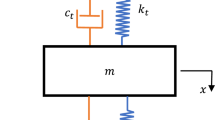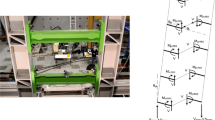Abstract
In this study, a new hybrid energy dissipation device is developed by combining two friction dampers (auxiliary and main fuse) in series to be used for the seismic control of two different earthquake intensities. Compared with the conventional friction dampers, the new hybrid damper has an advantage in that only the auxiliary fuse (with low sliding force) is activated for moderate earthquakes and both fuses work simultaneously for strong earthquakes. Cyclic loading tests of the combined hybrid dampers are carried out to evaluate their seismic energy dissipation capability. The obtained experimental force displacement indicates proper details of the new damper to create two performance levels. Finite element analyses of the test specimens are also carried out for comparison and have good agreement with the test results. Force–displacement characteristics, energy dissipation, and equivalent viscous damping are also derived and good agreement has been found. Moreover, it is demonstrated that by engaging the main fuse with non-loaded pretension bolts, the strength losses of the hybrid damper in the subsequent cycles are limited compared with the common friction dampers, which can be called the “resurrection-type” behavior of the main fuse in the main shocks. To evaluate the effects of the proposed damper, typical 3- and 9-story steel buildings are modeled and their seismic responses under 22 earthquake excitations are investigated using incremental dynamic nonlinear time-history. Comparison of incremental dynamic analysis (IDA) curves and their medians revealed that using a hybrid friction damper (HFD) reduces the probability of reaching all the defined damage states. Moreover, the reduction effect of HFD was recognizable in 9-story frames.


















Similar content being viewed by others
References
Andalib, Z., Kafi, M. A., Kheyroddin, A., & Bazzaz, M. (2014). Experimental investigation of the ductility and performance of steel rings constructed from plates. Journal of Constructional Steel Research, 103, 77–88. https://doi.org/10.1016/j.jcsr.2014.07.016
Andalib, Z., Kafi, M. A., Kheyroddin, A., Bazzaz, M., & Momenzadeh, S. (2018). Numerical evaluation of ductility and energy absorption of steel rings constructed from plates. Engineering Structures, 169, 94–106. https://doi.org/10.1016/j.engstruct.2018.05.034
ASCE/SEI 41-13. (2010). Seismic evaluation and retrofit of existing buildings. American Society of Civil Engineers; Reston, Virginia, USA.
ASCE/SEI 7-10. (2010). Minimum design loads for buildings and other structures. American Society of Civil Engineers; Reston, Virginia, USA.
Bazzaz, M., Andalib, Z., Kafi, M. A., & Kheyroddin, A. (2015). Evaluating the performance of OBS-CO in steel frames under monotonic load. Journal of Earthquakes and Structures, 8(3), 697–710. https://doi.org/10.12989/eas.2015.8.3.699
Bazzaz, M., Kafi, M. A., Kheyroddin, A., Andalib, Z., & Esmaeili, H. (2014). Evaluating the seismic performance of off-centre bracing system with circular element in optimum place. International Journal of Steel Structures, 14(2), 293–304. https://doi.org/10.1007/s13296-014-2009-x
Bazzaz, M., Kheyroddin, A., Kafi, M. A., & Andalib, Z. (2012). Evaluation of the seismic performance of off-centre bracing system with ductile element in steel frames. Steel & Composite Structures, 12(5), 445–464. https://doi.org/10.12989/scs.2012.12.5.445
BHRC. (2015). Iranian code of practice for seismic resistant design of buildings (Standard No. 2800) (4th ed.), Building Housing Research Center; Tehran, Iran.
Cheraghi, A., & Zahrai, S. M. (2016). Innovative multi-level control with concentric pipes along brace to reduce seismic response of steel frames. Journal of Constructional Steel Research, 127, 120–135. https://doi.org/10.1016/j.jcsr.2016.07.024
FEMA350. (2000). Recommended Seismic Design Criteria for New Steel Moment Frame Buildings, Federal Emergency Management Agency; Washington, DC, USA.
FEMA356. (2000). Commentary for the seismic rehabilitation of buildings, Federal Emergency Management Agency 7; Washington, DC, USA.
FEMA-P695 (2009). Quantification of building seismic performance factors, Report No. P695, Federal Emergency Management Agency; Washington, DC, USA.
Hanson, R. D. & Soong, T. T. (2001). “Seismic design with supplemental energy dissipation devices”, Oakland (CA): Earthquake Engineering Research Institute.
Hosseini, H. B., & Moaddab, E. (2017). Experimental study of a hybrid structural damper for multi-seismic levels. Proceedings of the Institution of Civil Engineers-Structures and Buildings, 170(10), 722–734. https://doi.org/10.1680/jstbu.15.00122
Ibarra, L. F., Medina, R. A., & Krawinkler, H. (2005). Hysteretic models that incorporate strength and stiffness deterioration. Earthquake Engineering & Structural Dynamics, 34, 1489–1511. https://doi.org/10.1002/eqe.495
Ibrahim, Y. E., Marshall, J., & Charney, F. A. (2007). A visco-plastic device for seismic protection of structures. Journal of Constructional Steel Research, 63(11), 1515–1528. https://doi.org/10.1016/j.jcsr.2007.01.007
Karavasilis, T. L., Blakeborough, T., & Williams, M. S. (2011). Development of nonlinear analytical model and seismic analyses of a steel frame with self-centering devices and viscoelastic dampers. Computers & Structures, 89(11–12), 1232–1240. https://doi.org/10.1016/j.compstruc.2010.08.013
Kim, D. H., Ju, Y. K., et al. (2009). Experimental Study on the Vibration Control Capacity of Hybrid Buckling-Restrained Braces. Journal of Korean Society of Steel Construction, 21(1), 83–91.
Kim, D. H., Ju, Y. K., Kim, M. H., & Kim, S. D. (2014). Wind-induced vibration control of tall buildings using hybrid buckling-restrained braces. The Structural Design of Tall and Special Buildings, 23(7), 549–562. https://doi.org/10.1002/tal.1066
Lee, C.-H., Kim, J., et al. (2016). Numerical and experimental analysis of combined behavior of shear-type friction damper and non-uniform strip damper for multi-level seismic protection. Engineering Structures, 114, 75–92. https://doi.org/10.1016/j.engstruct.2016.02.007
Marshall, J. D., & Charney, F. A. (2010). A hybrid passive control device for steel structures, I: Development and analysis. Journal of Constructional Steel Research, 66(10), 1278–1286. https://doi.org/10.1016/j.jcsr.2010.04.005
Mazzoni, S., & McKenna, F., et al. (2006). “OpenSees command language manual.” Pacific Earthquake Engineering Research (PEER) Center 264.
OpenSees (2014). The Open System for Earthquake Engineering Simulation. Pacific Earthquake Engineering Research Center (PEER). Available at: http://opensees.berkeley.edu
Smith, R. J., & Willford, M. R. (2007). The damped outrigger concept for tall buildings. The Structural Design of Tall and Special Buildings, 16(4), 501–517. https://doi.org/10.1002/tal.413
Soong, T., & Spencer, B. (2002). Supplemental energy dissipation: State-of-the-art and state-of-the-practice. Engineering Structures, 24(3), 243–259. https://doi.org/10.1016/S0141-0296(01)00092-X
Symans, M., Charney, F., et al. (2008). Energy dissipation systems for seismic applications: Current practice and recent developments. Journal of Structural Engineering, 134(1), 3–21.
Author information
Authors and Affiliations
Corresponding author
Additional information
Publisher's Note
Springer Nature remains neutral with regard to jurisdictional claims in published maps and institutional affiliations.
Rights and permissions
About this article
Cite this article
Shahbazi, B., Moaddab, E. A New Hybrid Friction Damper (HFD) for Dual-Level Performance of Steel Structures. Int J Steel Struct 21, 1332–1345 (2021). https://doi.org/10.1007/s13296-021-00507-9
Received:
Accepted:
Published:
Issue Date:
DOI: https://doi.org/10.1007/s13296-021-00507-9




